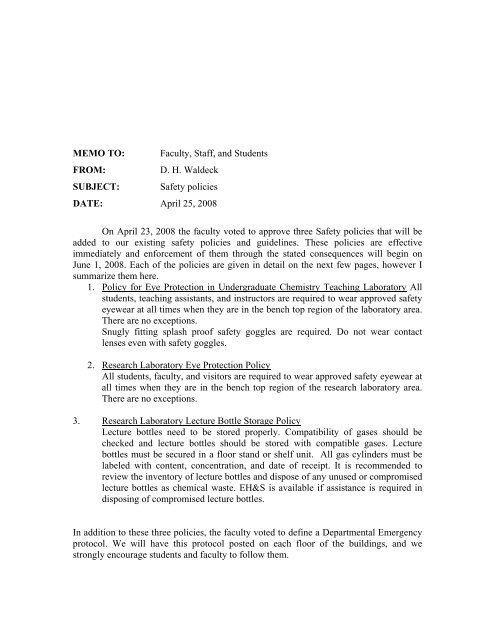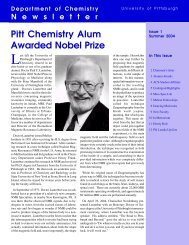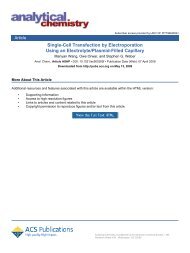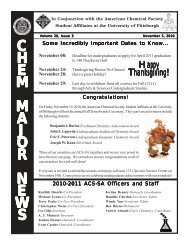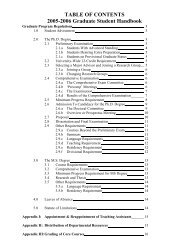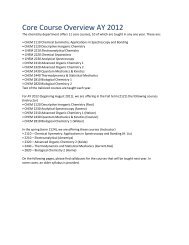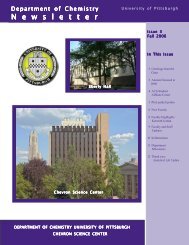MEMO TO: Faculty, Staff, and Students FROM: DH Waldeck SUBJECT
MEMO TO: Faculty, Staff, and Students FROM: DH Waldeck SUBJECT
MEMO TO: Faculty, Staff, and Students FROM: DH Waldeck SUBJECT
Create successful ePaper yourself
Turn your PDF publications into a flip-book with our unique Google optimized e-Paper software.
<strong>MEMO</strong> <strong>TO</strong>: <strong>Faculty</strong>, <strong>Staff</strong>, <strong>and</strong> <strong>Students</strong><strong>FROM</strong>:D. H. <strong>Waldeck</strong><strong>SUBJECT</strong>: Safety policiesDATE: April 25, 2008On April 23, 2008 the faculty voted to approve three Safety policies that will beadded to our existing safety policies <strong>and</strong> guidelines. These policies are effectiveimmediately <strong>and</strong> enforcement of them through the stated consequences will begin onJune 1, 2008. Each of the policies are given in detail on the next few pages, however Isummarize them here.1. Policy for Eye Protection in Undergraduate Chemistry Teaching Laboratory Allstudents, teaching assistants, <strong>and</strong> instructors are required to wear approved safetyeyewear at all times when they are in the bench top region of the laboratory area.There are no exceptions.Snugly fitting splash proof safety goggles are required. Do not wear contactlenses even with safety goggles.2. Research Laboratory Eye Protection PolicyAll students, faculty, <strong>and</strong> visitors are required to wear approved safety eyewear atall times when they are in the bench top region of the research laboratory area.There are no exceptions.3. Research Laboratory Lecture Bottle Storage PolicyLecture bottles need to be stored properly. Compatibility of gases should bechecked <strong>and</strong> lecture bottles should be stored with compatible gases. Lecturebottles must be secured in a floor st<strong>and</strong> or shelf unit. All gas cylinders must belabeled with content, concentration, <strong>and</strong> date of receipt. It is recommended toreview the inventory of lecture bottles <strong>and</strong> dispose of any unused or compromisedlecture bottles as chemical waste. EH&S is available if assistance is required indisposing of compromised lecture bottles.In addition to these three policies, the faculty voted to define a Departmental Emergencyprotocol. We will have this protocol posted on each floor of the buildings, <strong>and</strong> westrongly encourage students <strong>and</strong> faculty to follow them.
1. Policy for Eye Protection in Undergraduate Chemistry Teaching LaboratoryALL STUDENTS, TEACHING ASSISTANTS, AND INSTRUC<strong>TO</strong>RS ARE REQUIRED <strong>TO</strong> WEARAPPROVED SAFETY EYE WARE AT ALL TIMES WHEN THEY ARE IN THE BENCH <strong>TO</strong>P REGIONOF THE LABORA<strong>TO</strong>RY AREA. THERE ARE NO EXCEPTIONS.Snugly fitting splash proof safety goggles are required. Do not wear contact lenses evenwith safety goggles.OversightIt is expected that the lab instructor circulates through the bench top areasfrequently during the laboratory session. The lab instructor has the primary responsibilityfor enforcing safety rules <strong>and</strong> teaching proper laboratory procedures <strong>and</strong> techniques to thestudents. Eye safety violation was the principal violation of the laboratory safety policyobserved by spot inspections of General Chemistry laboratories during fall 2007. The labinstructor is expected to act as a model of lab safety practices <strong>and</strong> must also be vigilant inenforcing all safety rules, especially the policy regarding acceptable clothing <strong>and</strong>footwear.It is recommended that a rigorous program of supervision for laboratoryinstructors, which should include frequent visits to laboratory during times when studentsare performing experiments, be implemented by the General Chemistry Lab Coordinatoror other delegated authority. It is further recommended that the Lab Coordinator reportthe results of these visits to the Safety Committee each semester at a Safety Committeemeeting. In addition, the syllabus in any General Chemistry course with a laboratorycontain a statement of the rules or reference to the rules distributed in lab <strong>and</strong> thepenalties for violation of the safety requirements.EnforcementAny undergraduate student not in compliance with this rule will first receive averbal warning from the laboratory instructor. After a second offense, the lab instructorwill deduct 5 points from the grade for that day’s lab report. Any student receiving a thirdwarning during the same period of lab will be dismissed from that lab <strong>and</strong> receive a gradeof zero for that laboratory report. The lab instructor will email the name of the dismissedstudent to the Lab Coordinator <strong>and</strong> the Professor in Charge of that course. Any studentdismissed from a second laboratory that semester for violation of the eye safety policywill meet with the Professor in Charge to determine if additional action, such as dismissalfrom the course, or a grade of F for the course is appropriate. Any additional violations ofthis policy or other safety procedures will result in a grade of F for the course.Any lab instructor not in compliance with the eye safety policy as determined byunannounced inspections by the Lab Coordinator, Professor in Charge, or a member ofthe Safety Committee will receive a written warning from the Laboratory Coordinator.For the instructor, a violation of the policy includes failure to wear approved goggles orfailure to enforce the policy for students. If there is a second warning during that semesteror laboratory period, the lab instructor will receive an unsatisfactory rating for teachingperformance. Any lab instructor with three warnings in a given semester will meet withthe Laboratory Coordinator <strong>and</strong> a member of the Safety Committee to determine if arecommendation for dismissal from the teaching program should be forwarded to theDepartment head or the representative of the department head.
2. Research Laboratory Eye Protection PolicyALL STUDENTS, FACULTY AND VISI<strong>TO</strong>RS ARE REQUIRED <strong>TO</strong> WEAR APPROVED SAFETY EYEWARE AT ALL TIMES WHEN THEY ARE IN THE BENCH <strong>TO</strong>P REGION OF THE RESEARCHLABORA<strong>TO</strong>RY AREA. THERE ARE NO EXCEPTIONS.Appropriate eye wear will be made available next to all laboratory entrances. TheDepartment will be implementing this over the next month.OversightIt is expected that the lab supervisor/faculty member enforces safety rules, acts asa model of lab safety practices <strong>and</strong> is vigilant in enforcing all safety rules, including thepolicy regarding acceptable clothing <strong>and</strong> footwear.EnforcementAccording to Appendix VI of the 08 Graduate Student H<strong>and</strong>book3. Research Laboratory Lecture Bottle Storage PolicyLECTURE BOTTLES NEED <strong>TO</strong> BE S<strong>TO</strong>RED PROPERLY. COMPATIBILITY OF GASES SHOULD BECHECKED AND LECTURE BOTTLES SHOULD BE S<strong>TO</strong>RED WITH COMPATIBLE GASES. LECTUREBOTTLES MUST BE SECURED IN A FLOOR STAND OR SHELF UNIT. ALL GAS CYLINDERS MUSTBE LABELED WITH CONTENT, CONCENTRATION, AND DATE OF RECEIPT. IT ISRECOMMENDED <strong>TO</strong> REVIEW THE INVEN<strong>TO</strong>RY OF LECTURE BOTTLES AND DISPOSE OF ANYUNUSED OR COMPROMISED LECTURE BOTTLES AS CHEMICAL WASTE. EH&S IS AVAILABLEIF ASSISTANCE IS REQUIRED IN DISPOSING OF COMPROMISED LECTURE BOTTLES.A rack for appropriate lecture bottle storage can be fabricated in the mechanical shop.OversightIt is expected that the lab supervisor/faculty member enforces safety rules, acts asa model of lab safety practices <strong>and</strong> is vigilant in enforcing all safety rules, including thepolicy regarding lecture bottle storage.EnforcementUpon notification by EH&S, the Safety Committee reviews the case <strong>and</strong> makesrecommendations for sanctions to the Department Chair.
Chemistry Department Emergency ProtocolIn case of a flood, fire or other emergency that has any potential to affect equipment,personnel, chemicals or paper records, the following procedure should be followed:1) Pull the fire alarm to evacuate the building if you judge that there is any physicaldanger to occupants.2) Contact University Police at 412-624-2121.3) Contact the “Primary Contact” for each of the labs <strong>and</strong>/or offices that are affectedby the emergency. Usually, this is the Professor (P.I.) or Lab Supervisorresponsible for the space; if he or she cannot be contacted, then at least one of the“Responsible Parties” should be called. Leave messages if contacts do not answer.4) Contact the Director of Facilities <strong>and</strong> EH&S <strong>and</strong> involve them as much as possiblein decision making concerning the appropriate response to the emergency.5) If at all possible, the advice/supervision of a faculty member or graduate studentfrom the group whose lab is affected should be obtained before anyone enters a lab.Allowing people to enter labs to “clean them up” or ameliorate damage bycovering equipment without any supervision by a chemically trained person cancreate a potentially dangerous situation.6) An email summary of the event should be sent out by the Director of Facilities tobuilding occupants as soon as possible after the event.Note: Even minor safety incidences need to be reported to the appropriate faculty or staffwithout undue delay.


